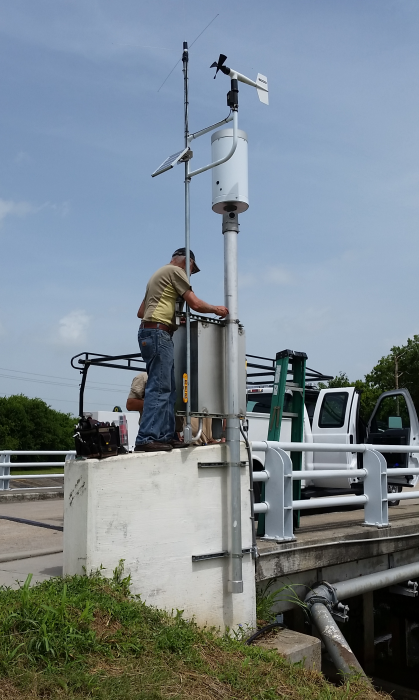







In February of 2015, Campbell Scientific was awarded a bid to supply the Harris County Flood Control District (HCFCD) with ALERT2 systems to upgrade their aging, legacy ALERT flood-warning system (FWS). (See case study Texas: Transitioning to ALERT2.) By December of 2015, they had completely upgraded the more than 150 stations in their flood-warning network with Campbell equipment. The systems were special, prewired systems that included a CR800 (later replaced by the CR300), AL200, and VHF radio. These panels were designed in conjunction with HCFCD and were built up by Campbell’s Production group in the short span of a couple of weeks. Campbell Scientific worked with Telos Services and Distinctive AFWS Designs to provide a custom-tailored program and user interface.
HCFCD and their integrators, Telos Services and Distinctive AFWS Designs, installed the station upgrades between August 2015 and December 2015. As part of the upgrade process, HCFCD took the time to completely overhaul each site—an investment that would pay dividends later.
Since the system was upgraded, it has been tested by multiple 100-plus-year rain and flood events. In August of 2017, Hurricane Harvey became the largest, most thorough test of the HCFCD ALERT2 FWS to date. Every watershed in the HCFCD’s jurisdiction experienced at least a 100-year rain event, and some areas exceeded the 20,000-year rainfall frequency. An average of 33.7 inches fell across the entirety of Harris County, inundating the region with more than one trillion gallons of water—enough to keep Niagara Falls flowing for more than a week. Flooding was catastrophic and Hurricane Harvey became the flood of record for many channels, with nearly 70,000 structures damaged by flooding.
Throughout the storm, the Campbell Scientific systems worked accurately and reliably. The four-day event generated over 250,000 data transmissions, with 99.2% of this data being successfully received and 99.4% of the data being validated and deemed good by the system. The performance of the FWS was impressive, given the size of the FWS network and the magnitude of Hurricane Harvey, both in size and intensity.
The data generated by the FWS was then distributed to emergency-management organizations, first responders, media outlets, and the general public. Being able to supply reliable and timely data meant that the HCFCD, National Weather Service, U.S. Geological Survey, U.S. Army Corps of Engineers, and U.S. Coast Guard were working with good information as they managed the crisis. The website, harriscountyfws.org, which allows the general public to view rainfall totals and water levels in near real time, was viewed 6.3 million times by more than one million unique users, or about one out of four Harris County residents. Social media platforms (Facebook, Twitter, and Reddit) were used to convey information to an even broader audience. Providing clear and concise information that was easily digestible by the public undoubtedly prevented further loss of life during this record-breaking storm.
Case Study Summary
Application
Upgrading system that monitors flood conditions and provides warningsLocation
Harris County, TexasProducts Used
CR800 AL200 ALERT121A StandardContributors
Ken Conner, Campbell Scientific, Inc.Participating Organizations
Harris County Flood Control District (HCFCD)Measured Parameters
Rainfall, stage, wind speed, wind direction, air temperature, relative humidityRelated Website
Harris County Flood Warning System NASA Earth Observatory (image)View the PDF